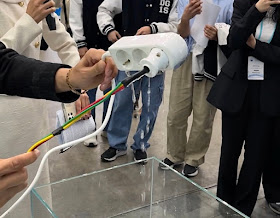Korea International Water Week 2024: "Building Smart Water Future by Sharing Experience and Technology"
안녕하세요! This is Qisty writing. I am excited to update about my trip to Korea International Water Week (KIWW) 2024 from November 13 to 16, 2024, at EXCO in Daegu, South Korea. This annual event brought together experts, policymakers, and industry leaders from over 70 countries to address global water challenges and share innovative solutions. KIWW 2024 featured a comprehensive agenda, including:
- Water Leaders' Round Table: High-level officials and experts discussed strategies to address water issues worsening by climate change, culminating in an action declaration.
- World Water Partnership: Representatives from previous and upcoming World Water Forum host countries shared insights and discuss future directions for global water management.
- Technology, Implementation, and Policy (TIP) Platform: Sessions focusing on key water issues, technological advancements, and policy discussions.
- World Water Challenge: An international contest seeking innovative solutions to global water problems, with finalists presenting their ideas during the event.
- Youth Water Forum Asia: An international exchange event focusing on water issues, specifically designed for the younger generation.
- Korea Junior Water Prize: A competition encouraging young minds to develop solutions for water-related challenges, with winners gaining international recognition. The winner would further compete in the Stockholm Water Prize.
- International Water Industry Conference: Approximately 250 water industry experts from 11 countries participated, discussing global water market prospects and technological trends.
- Water Business Square: An exhibition featuring over 60 domestic and international water companies, facilitating business exchanges, public procurement consultations, and showcasing new products and technologies, related to water, including tap water production, ultra-pure water, and industrial water.
Korea Minister of Environment, Kim Wan-sup stated, “In order to wisely address an unprecedented climate crisis, innovative water management policies and active cooperation from around the world are essential.” The keynote speaker from KAIST, Prof. Hyungjun Kim also highlighted the current state of the climate that human-induced climate change is already affecting many weather and climate extremes in every region across the globe. He showed a graph of the near-linear relationship between the cumulative CO 2 emissions and global warming for five illustrative scenarios will produce 4500 GtCO 2 from 1850 until year 2050. He also displayed the illustration of Japan and Shohei Ohtani, concluding a similarity between the two entering the 50/50 club (Japan for experiencing a notable rise in the number of extremely heat days and night with maximum temperatures exceeding 35°C over 50 days; Ohtani for hitting at least 50 home runs and stealing 50 bases in a single season).
I participated in the TIP Platform of Youth Researcher Session: Innovative Approaches to Flood Protection Investment in an Uncertain World organized by Japan Water Forum and was opened by Dr. Mikio Ishiwatari as the Board Director . It is crucial to create innovative methods for obtaining funding for flood protection in a time of significant societal and climatic uncertainty. Even while flood protection plays a major role in quality-oriented growth by addressing poverty, lowering inequality, and protecting ecosystems, traditional valuation techniques find it difficult to fully account for these complex advantages. T he session discussed cutting-edge approaches that can equip policymakers with comprehensive evidence for informed decision-making on flood protection investments. My research topic focused on developing a framework for the comparative valuation of the primary benefits (flood risk mitigation) and co-benefits of green infrastructure (green job creation, cropland productivity enhancement, carbon credits, and recreation establishment) and gray interventions in river area. Along with other participants from fellow University of Tokyo student, Kongju National University, and Seoul National University, South Korea, we brought up fruitful discussion about other research topics of the spillover effects for flood control investment, reducing poverty and inequality by investment in flood protection, application and evaluation of Nature-based Solutions for flood mitigation, and the relationship between flood damage and flood vulnerability focusing on property damage and human casualties.
Other photos from the events
There was a session called Youth Water Forum Asia, a platform for high school students from various countries to present water challenges and solutions specific to their regions, share innovative solutions to water-related challenges, promote cooperation among the younger generation to exchange views on both local and global water issues. This year's participants came from high schooler from Japan, Korea, and Indonesia! (my country). Everybody had done amazing things and contributed to the society in such a young age. Japanese participants from Kumamoto city even delivered a presentation with animation video they created to raise awareness of protecting groundwater in Kumamoto which serves as 100% water supply (that's why their tap water tastes really good with balanced minerals and less disinfection chemical solution).
Together with the Youth Water Forum Asia Participants, we explored the exhibitions where companies showcased technologies and services related to water, including tap water production, ultra-pure water, and industrial water. The Korea Institute of Hydrological Survey and the Ministry of Water Resources and Meteorology of Cambodia also collaborated to support sustainable water management and enhance hydrological survey capabilities in Cambodia, while expanding cooperation between the two countries.
Then, we met the mascots of this year's KIWW event and the mascot of Daegu Metropolitan City (so cute!)
Suseong-Gu River and Lake, Daegu
Daegu City from Above
I rode three different modes of transportations in Daegu: bus, subway, and monorail. Also, in contrasts with countries like Japan or the United Kingdom, the driving custom in South Korea follows the right-hand traffic system, which means drivers drive on the right side of the road and the steering wheel is located on the left side of the vehicle.
That's all I want to share about. South Korea is very interesting to visit, 감사합니다 (gam-sa-ham-ni-da)!
Warmly,
Qisty





















.JPG)



















No comments:
Post a Comment